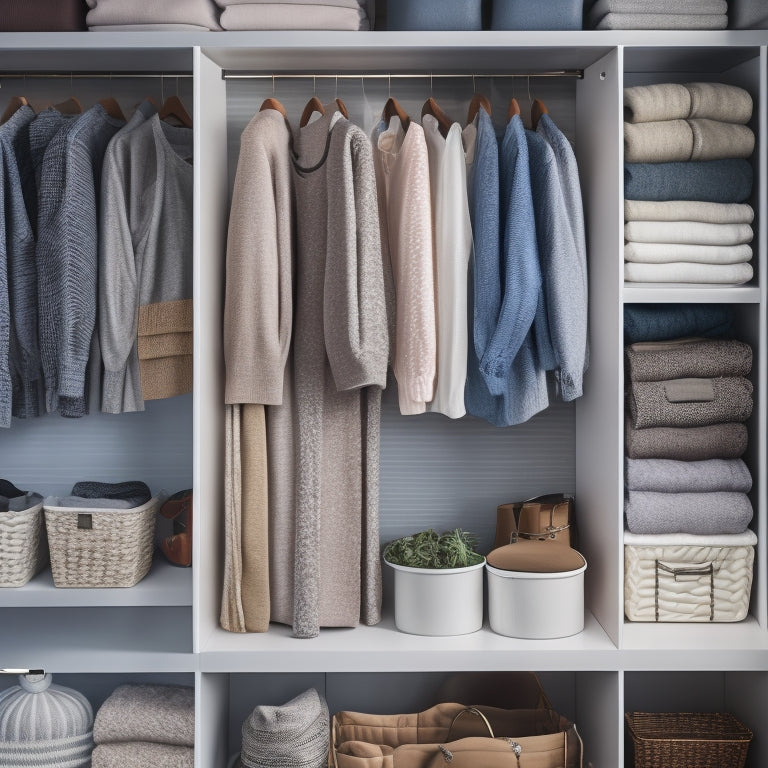
3 Must-Know Garment Storage Tips for Beginners
Share
To start organizing your garments effectively, focus on these three tips. First, employ vertical storage solutions like hanging racks to maximize space and keep clothes wrinkle-free. Next, categorize your clothing by type, streamlining access and enhancing closet efficiency. Finally, pay attention to fabric care; store breathable natural fibers in cotton bags and fold delicate items like silk to prevent snags. These strategies not only maintain your garments' quality but also create a clutter-free environment. Keep exploring to uncover more tips that can enhance your storage game even further!
What You Need to Know
- Categorize garments by type to streamline organization and make finding items easier.
- Use breathable storage containers like cotton or linen bags to protect clothes from moisture.
- Fold heavier fabrics like wool and store them in a cool, dry place to prevent damage.
- Invest in padded hangers for delicate materials like silk to avoid snags and maintain shape.
- Regularly reassess and declutter your wardrobe to keep only what you truly wear and love.
Space-Saving Design Advantages
When it comes to maximizing your storage, vertical solutions can make a world of difference.
Utilizing space-saving ideas like double rods and hanging organizers can greatly enhance your closet's efficiency.
Think about using shelves or hooks to free up precious floor space.
Plus, multi-functional furniture like ottomans or benches can help you store garments while adding style to your room.
Vertical Storage Solutions
Looking to maximize your closet space? Vertical storage solutions are your best friend. By utilizing the height of your closet, you can create a more organized environment that lets you breathe easy.
Start by installing hanging racks. These allow you to store clothes in layers, making it easier to see everything at a glance. Plus, they free up precious floor space, giving you room for other essentials.
Wall organizers are another fantastic option. These versatile tools can hold accessories, shoes, or even lightweight bags, keeping them off the ground and within easy reach.
With wall organizers, you can customize your storage to fit your unique style, turning your closet into a personalized haven.
Think outside the box! Use vertical space not just for hanging clothes, but for incorporating shelves or hooks. By going vertical, you're not just saving space; you're also creating an efficient system that enhances your daily routine.
Welcome these solutions, and you'll find that a clutter-free closet isn't just a dream but a reality, giving you the freedom to choose what to wear without the chaos.
Multi-Functional Furniture Options
Multi-functional furniture can change your storage game, especially in small spaces. These innovative pieces not only serve multiple purposes but also provide convertible storage solutions that help you maximize every inch of your home. With hidden compartments, you can keep your garments organized and easily accessible while maintaining a clean aesthetic.
Here's a quick look at some popular multi-functional furniture options:
| Furniture Type | Functionality | Space-Saving Benefits |
|---|---|---|
| Ottoman | Seating + Storage | Store shoes or accessories |
| Sofa Bed | Seating + Sleeping | Guest bed without extra space |
| Coffee Table | Table + Storage | Hidden compartments for blankets |
| Storage Bench | Seating + Storage | Ideal for shoes or seasonal wear |
Choosing furniture with these features not only declutters your space but also gives you the freedom to adapt your environment to your needs. When it comes to storage, opt for designs that allow you to keep your essentials tucked away yet readily available. Accept the versatility of multi-functional furniture, and watch your small space convert into an organized oasis.
Maximizes Closet Organization Efficiency
To maximize your closet's organization efficiency, start by utilizing vertical space effectively.
Hanging racks can be an excellent option for dresses and suits, while shelving units are perfect for storing seasonal clothing or accessories.
Next, categorize your garments by type, making it easy to find what you need quickly.
Consider employing optimal storage conditions to guarantee your clothes remain in pristine condition.
Utilize Vertical Space
Maximizing closet organization efficiency hinges on your ability to employ vertical space effectively. By thinking upwards, you can free up useful floor space and create a more functional environment. Here are some strategies to contemplate:
| Storage Solution | Benefits |
|---|---|
| Hanging Racks | Keeps clothes visible and accessible. |
| Wall Shelves | Provides extra storage for accessories and shoes. |
Using hanging racks allows you to make use of your closet's height while keeping garments wrinkle-free. Opt for adjustable racks to customize your storage as your needs change. Wall shelves can serve as a stylish display for shoes, bags, or folded items, making it easy to grab what you need without rummaging through piles.
Don't forget to make use of the back of your closet door! Hooks or a small shelving unit can further enhance your vertical space. By implementing these tips, you'll create an organized closet that feels open and liberating. Accept the freedom of a well-organized space where everything has its place, and you can easily access your favorite pieces.
Categorize by Type
When it comes to organizing your closet, categorizing clothes by type can make a world of difference. By sorting your garments into specific clothing types—like tops, bottoms, dresses, and outerwear—you'll create a streamlined system that's easy to maneuver. This not only saves you time when getting dressed but also helps you see what you truly have.
Start by designating areas in your closet for each category. Use storage bins for seasonal items or less-frequently worn clothing. Label these bins clearly to keep everything organized. Consider using clear bins so you can quickly identify the contents without rummaging through.
You can also fold or hang items based on their type. For example, hang your blouses together and fold your sweaters to save space. This approach maximizes your closet's efficiency and gives you the freedom to access your clothing easily.
Additionally, regularly reassess your categories. If you find that certain clothing types aren't being worn, consider donating them. Embracing this method not only enhances your closet organization but also promotes a more intentional wardrobe, allowing you to enjoy your space fully.
Unique Fabric Breathability Benefits
When it comes to fabric breathability, natural fibers like cotton and linen offer distinct advantages. They allow air circulation and wick away moisture, keeping your garments fresh and comfortable.
Additionally, breathable fabrics greatly enhance overall performance during routines, as they help maintain coolness and dryness during intense activities. Understanding these benefits can help you choose the right materials for ideal storage and wear, especially when considering the importance of breathable fabrics.
Natural Fiber Advantages
Natural fibers, like cotton, linen, and wool, offer exceptional breathability that synthetic fabrics often can't match. When you choose garments made from these materials, you're embracing a world of comfort and freedom.
Natural fibers allow air to circulate, keeping you cooler in the summer and warmer in the winter. This breathability is one of the key natural fiber benefits, making your wardrobe not just stylish but also functional.
Moreover, opting for natural fibers supports sustainable fashion. By choosing materials that are biodegradable and produced with less environmental impact, you're contributing to a healthier planet. This choice reflects a lifestyle that values both personal comfort and ecological responsibility.
Natural fibers can also wick away moisture, which can help you feel fresher throughout the day. When you're in tune with what you wear, you're more likely to express yourself freely.
Moisture Management Techniques
Understanding how to manage moisture effectively can enhance the benefits of natural fibers in your wardrobe. When it comes to garment storage, humidity control is vital. High humidity can lead to mold and mildew, damaging your favorite clothes. To combat this, consider using moisture absorbers like silica gel packets or activated charcoal. These little powerhouses can help keep your storage areas dry, ensuring your garments stay fresh and breathable.
In addition, it's important to store your clothes in breathable containers. Opt for cotton or linen bags instead of plastic, which can trap moisture and create a damp environment. This approach not only allows your fabrics to breathe but also helps maintain their natural properties over time.
Regularly check your storage space for any signs of excess moisture or musty odors. If you notice any issues, increase air circulation by opening windows or using a dehumidifier.
Selecting Based on Fabric Type
When storing your garments, it's essential to take into account the fabric type. Different fabrics require specific storage methods to maintain their quality, and seasonal changes can also impact how you should store them.
For instance, high-quality materials like spandex and nylon, commonly used in affordable dancewear options, may need to be stored in a way that preserves their elasticity.
Fabric-Specific Storage Methods
Choosing the right storage method for your garments can greatly extend their lifespan, especially when you consider the fabric type.
For cotton care, fold your garments neatly to avoid creasing, and store them in breathable containers.
When it comes to silk storage, opt for padded hangers or garment bags to prevent snags and maintain their luxurious feel.
Wool preservation requires a bit more attention; always clean your wool items before storing, and use moth prevention measures like cedar blocks or lavender sachets.
For linen organization, keep your linen items folded and in a cool, dry place to prevent mildew. They also benefit from a gentle press before storage to maintain their crispness.
Synthetic fabrics, while more durable, should still be stored carefully to avoid stretching or snagging—fold them rather than hanging.
Remember to treat delicate items with extra care; a breathable garment bag can be your best friend.
Regular fabric maintenance and seasonal rotation are key; rotate your garments to prevent them from sitting idle too long and confirm they stay fresh.
Seasonal Fabric Considerations
Selecting the right fabrics for each season can make a significant difference in your comfort and style. For warmer months, opt for lightweight, breathable materials like cotton and linen. These fabrics allow better airflow, keeping you cool and comfortable.
On the flip side, when the temperature drops, adopt heavier fabrics such as wool and flannel. They provide warmth and insulation, making chilly days much more bearable.
To maintain your garments, pay attention to fabric care. Each material has its own cleaning and storage requirements, so read the labels. For instance, delicate fabrics like silk need gentle washing and proper hanging, while sturdier textiles can withstand machine washing.
As you engage in seasonal rotation, guarantee you store off-season clothes properly. Use breathable garment bags or bins, and avoid overcrowding, which can cause wrinkles and damage.
Durability Against Environmental Factors
When storing your garments, humidity can be a silent enemy that leads to mold and deterioration.
You'll want to keep your clothes in a controlled environment, using moisture absorbers or a dehumidifier if necessary.
Protecting From Humidity
Humidity can wreak havoc on your garments, leading to mold, mildew, and unwanted odors. To keep your clothes fresh and extend their lifespan, you'll want to focus on humidity control and moisture absorption. Here are some effective strategies to take into account:
| Method | Benefits | Tips |
|---|---|---|
| Use Silica Gel Packs | Absorb excess moisture | Place in drawers or bags |
| Invest in Dehumidifiers | Regulate room humidity levels | Ideal for storage areas |
| Store in Breathable Bags | Prevent moisture buildup | Avoid plastic, use cotton |
| Hang Clothes Properly | Allow air circulation | Use padded hangers |
| Regularly Rotate Items | Prevent musty odors | Keep garments fresh |
Frequently Asked Questions
How Can I Prevent Moths From Damaging My Stored Clothes?
To prevent moths from damaging your stored clothes, use moth repellents like cedar or lavender. You can also try natural solutions, such as essential oils, to keep those pesky pests away and protect your garments.
What's the Best Way to Store Seasonal Clothing?
To store seasonal clothing effectively, practice seasonal rotation, use breathable containers, and prioritize fabric care. Clean your garments, fold them neatly, and keep them in a cool, dry place to maintain their quality and longevity.
How Often Should I Clean My Stored Garments?
You should check your stored garments every six months for cleaning frequency. If your storage environment is humid or dusty, consider cleaning them more often to keep them fresh and ready for when you need them.
Can I Use Vacuum Bags for Delicate Fabrics?
Using vacuum bags for delicate fabrics can feel like wrapping treasures in a protective cocoon. They offer vacuum bag benefits by saving space and safeguarding your garments, but remember fabric protection tips to avoid crushing or damaging them.
What Types of Hangers Are Best for Preserving Garment Shape?
To preserve garment shape, use hangers made of wood or velvet. Wooden hangers provide sturdy support, while velvet hangers grip fabrics without slipping. Avoid wire hangers, as they can distort your clothes over time.
Explore More
By now, you've learned the essentials of garment storage, but there's one vital tip you might be missing that could alter everything. Imagine opening your closet to find not just organized clothes, but pieces that last longer and look better! With the right techniques, you can protect your favorite items from wear and tear. So, are you ready to change your storage game and uncover the secret to maintaining your wardrobe's freshness? Don't wait—start now!
Related Posts
-

5 Best Free YouTube Dance Makeup Tutorials
You're ready to elevate your dance performances with stunning makeup looks, and we're here to help! Our top 5 free Yo...
-

Legal Safeguards: Makeup Artist Liability Release Form
A well-crafted liability release form is crucial for makeup artists to protect themselves from potential legal claims...
-

Dynamic Dance Designs: Unleash Your Creativity
By tapping into the limitless potential of Dynamic Dance Designs' cutting files, you can break free from creative con...


